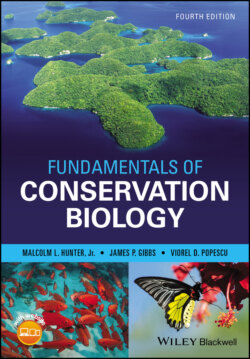Читать книгу Fundamentals of Conservation Biology - Malcolm L. Hunter Jr. - Страница 95
Measuring Genetic Diversity
ОглавлениеThere are many methods to determine qualitative variation among individuals and populations in the types of alleles present at a given locus. An older but still used, indirect technique, called protein electrophoresis, involves extracting a “soup” of all the enzymes present when tissues of an individual (e.g. a leaf sample, skin clip) are crushed and their cell contents released. A sample of this soup is placed into a gel made of starch and water and subjected to an electrical field. Different alleles for particular genes produce different variations of enzymes called allozymes that move at different rates based on slight changes in their protein structure that alter their electrical charges. By probing the gel with dyes that express only when they encounter a particular allozyme, you can see with your own eyes genetic variation at the molecular level based on how slowly or quickly different proteins with different electrical charges move down the gel.
More modern methods snip DNA into fragments and then separate and characterize these fragments using electrophoresis. Different alleles produce different fragment lengths. These methods are described briefly in Hartl (2000), and, more completely, in Barnes and Breen (2010). A more direct method, called DNA sequencing, involves determining the sequence of adenine, thymine, cytosine, and guanine along particular stretches of DNA of interest. This is now a widespread, more exacting technique used to measure genetic diversity. Sequencing is now increasingly done at the level of entire genomes, that is, the complete set of DNA within a single cell of an organism, instead of just particular genes or gene products (allozymes). This is the essence of the new field of genomics that is transforming the measurement of genetic diversity. Genome‐wide sequencing provides the ultimate degree of genetic resolution. With it we can understand not only how the genome is organized (its “structure”) but what all its parts actually “do” (what gene codes for what trait) and how they work together (its “function”). Genome‐level investigations have yielded surprising results; for example, we have learned that humans are not the epitome of genetic sophistication, and that the genome of the humble Mexican axolotl is made up of 32 billion base pairs, 10 times more than the human genome (Nowoshilow et al. 2018). This creates another challenge, however: making sense of the vast amount of data generated by genome‐wide sequencing – a daunting task. Doing so is the main focus of the rapidly expanding field of bioinformatics enabled by high‐speed computers. Together genomics and bioinformatics are transforming our understanding of the genetic basis for how organisms functions and ultimately how differences among individuals are manifested as distinct populations, species, and higher taxa like families. A practical example of the application of genomics to endangered species conservation is elucidation of the most important genetic vulnerabilities of endangered populations of island foxes and prioritization of management actions to address them (Funk et al. 2016).
Despite the promise of genomics, sequencing entire genomes is still quite laborious and costly. Therefore, until genomic analysis becomes more routine, a small sample of genes is still typically selected for measurement of genetic diversity and identity. We assume the pattern this subset of genes shows is reflective of the entire genome. Similarly, it is usually not possible to test all the individuals in a population; thus, a sample of individuals is used. After the allelic distribution for a sample of genes from a sample of individuals has been determined, an index to describe these distributions quantitatively can be calculated. Conservation biologists are most interested in indices of two important genetic properties of populations – polymorphism and heterogeneity – to quantify genetic diversity and guide conservation decision‐making.
